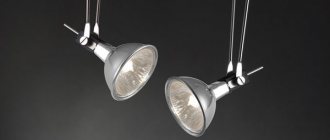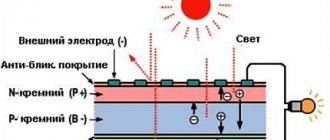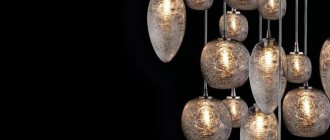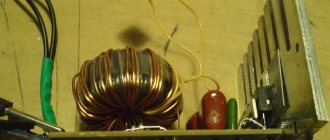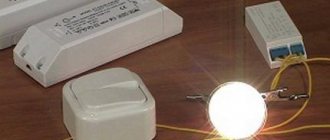Device and principle of operation
The filling of halogen light bulbs is in many ways similar to incandescent filaments: the same glass bulb, filament body and base. However, these light sources contain iodine and bromine.
Passing through the filament body, the current heats up the tungsten filament, which leads to glow. Due to the high temperature, tungsten atoms are released, which interact with halogens (iodine and bromine). The reaction prevents the deposition of metal elements on the inner walls of the lighting device, which can significantly increase the life of the light bulb.
Thus, the operating principle of a halogen light bulb is based on the use of a tungsten-halogen cycle:
- Evaporation of tungsten.
- Transport of particles by diffusion or convection to areas of lower temperature.
- The appearance of stable molecules of tungsten and halogen compounds.
- Transporting the emerging molecules to areas with high temperatures - to a heated tungsten spiral.
- The decomposition of molecules as a result of exposure to elevated temperature and the release of tungsten atoms onto the surface of the luminescent body.
The processes described above reduce the impact of two key disadvantages of standard incandescent light bulbs:
- The body of the flask does not darken, since the evaporated tungsten particles return to the filament.
- The glow body is regenerated, which increases the service life of the light bulb.
At the same time, the tungsten-halogen cycle is not without its disadvantages:
- Reactions where iodine is used are impossible without an oxygen environment. Since hydrogen compounds (methyl iodide and methylene) are used as fillers, a water cycle is carried out in the flask, accelerating the destructive processes in the filament.
- Iodine does not allow the filament to be completely regenerated, since the return of tungsten atoms occurs in a chaotic manner. In this case, the most overheated areas of the glow body are not restored. The consequence is the rapid evaporation of tungsten from areas exposed to critical temperatures and burnout of the filament.
- The disadvantages of using iodine also appear in other matters: aggressiveness when interacting with metals, absorption of a considerable part of the radiation in the green-yellow part of the spectrum. There is also an insufficiently developed halogen dosing technique.
The listed disadvantages are compensated by the use of other types of halogens. For example, bromine compounds (ethyls and ethylenes) have recently become widespread. It is also possible to use fluorine or chlorine. Fluorine is especially interesting, since it is most effective in enhancing thread regeneration. A significant limiting factor for bromine, fluorine and chlorine is their aggressiveness.
Advantages and disadvantages of halogen lamps
This type of lighting device has a number of undeniable advantages compared to incandescent lamps. They have a longer service life, especially if the operating rules are followed, as well as lower energy consumption.
Due to the increased light output, the devices are characterized by a particularly bright luminous flux, which can have a warm or cool tint.
Consumers are offered a wide range of models of this type, differing in size, shape, as well as the brightness and tone of the light source. This allows you to find the ideal option for illuminating any space.
The light emitted by halogen sources is evenly distributed throughout the room. This provides comfort and helps reduce eye fatigue
Since the use of halogens prevents the deposition of tungsten on the glass walls, such devices can be made compact. The small volume of the flask also helps to increase the service life and efficiency.
The lamps in question tolerate unfavorable environmental factors, including sudden temperature changes. Thanks to this, they are perfect for outdoor lighting, especially if you consider their tightness.
The design does not use harmful substances, therefore halogen devices are considered environmentally friendly and do not require special disposal. At the same time, you should not put them in glass containers, since the flasks are made of quartz material, which has different characteristics.
Halogen lamps also have a number of serious disadvantages. When using them, fire safety regulations must be strictly observed.
Since the tungsten spiral strongly heats the bulb, such devices emit an increased amount of heat, which is why it is undesirable to install them in easily melting chandeliers or other lighting devices.
It is also not recommended to mount light bulbs near the ceiling; If necessary, special pads can be used.
The downside of such products is also the low-frequency noise that appears in the AC network if they are used in conjunction with a dimmer.
The lamps are also sensitive to voltage changes, so it is recommended to turn them on through a special transformer, which can significantly increase their service life.
Halogen devices are used in various fields. They are used in household lighting fixtures, microwave ovens, photo and video recording devices, car headlights, and street spotlights.
Due to high temperatures, lamps are more susceptible to grease contamination. Do not touch the surface of the flask with your bare hands, as this may cause burnout or even disintegration of the product.
You should install the devices wearing gloves or using a clean cloth. In case of accidental contact with skin, it is advisable to immediately wipe the product with microfiber soaked in alcohol.
Application
Despite the fact that halogen light bulbs are inferior in efficiency to LED and fluorescent light sources, they are popular. In particular, 220 V lamps with dimmers easily replace standard incandescent light bulbs.
Halogen devices are used as lighting for cars. This light source is ideal for this area because it provides high light output, long service life, resistance to voltage surges, and has a small bulb. Halogen lamps are also used in spotlights, ramps, and for lighting during photography and video filming. They are used in silk-screen printing and flexographic printing, when drying materials that are sensitive to ultraviolet radiation.
Halogen light sources are used as heating elements. We are talking about using them in electric stoves, microwave ovens and blowtorches.
Where are halogen lamps used?
Halogen lamps are durable and bright lighting devices that are resistant to temperature and voltage changes. The bulbs of halogen lamps are made of heat-resistant and resistant to mechanical damage quartz, thanks to which this lamp can withstand large temperature changes and can have various sizes from large to miniature. Therefore, they are widely used in lighting devices for cars and other vehicles.
Halogen lamps are often and widely used in everyday life. They are built into various systems of suspended or suspended ceilings, and are also used when installing spot lighting or organizing various types of lighting, installed in chandeliers and various lamps. They are most often used when taking photos and videos using halogen spotlights and other lighting devices based on them.
Types of halogen light bulbs
Halogen light bulbs are classified according to power sources:
- low-voltage version with 12 Volt driver;
- incandescent lamps 220V.
The classification of lamps is shown in the figure below.
Low voltage light bulbs can also be connected to a dedicated 220V power supply, but only if a step-down transformer is provided. This device reduces the voltage to an acceptable level (12 Volts). Halogen bulbs of this type have a pin base G4, G9, GU10, G12. The H4 type base is also used in the automotive industry.
Types of bases are shown in the following figure.
Light bulbs are usually divided into several types depending on the features of their design:
- linear;
- capsule;
- with reflector;
- with a remote flask;
- low voltage;
- halogen chandeliers;
- IRC halogen light sources.
Linear
The production of halogen light sources began with this type of light bulb. Such lamps are still produced today. Linear light sources have a pair of pin holders on both sides of an elongated bulb. For domestic purposes, such devices are rarely used due to their high power (from 1 to 20 kW).
Capsule
Such light bulbs are characterized by their small dimensions. Capsule light sources are used to illuminate interiors. Typically G4 and G9 sockets are used. As for G9, this base is designed for a 220 V network. Due to their compactness and low power, capsule devices are often installed in open-type luminaires.
With reflector
Halogen light bulbs with reflectors are also called directional light bulbs. A similar effect is achieved through the use of a reflector, which is made in one of two options - interference or aluminum. In the case of an aluminum reflector, heat is dissipated forward, while the interference design involves dissipation of heat to the rear. Also, devices with a reflector are made with or without a protective cover. Lamps with a reflector are equipped with different types of bases: for a 220 V network or low-voltage ones for 12 Volts.
With a remote flask
External bulb devices are often confused with standard incandescent bulbs. They have a similar design, including an E14 or E27 threaded base, the same glass bulb and filament body. But inside a light bulb with a remote bulb there are halogens.
Halogen chandeliers
Light sources of this type are produced with E17 or E27 socket. One of the main characteristics of chandeliers is the small size of the bulbs; they are almost invisible. Chandeliers are usually designed to operate on a 220 V network, but low-voltage lamps are also available. In the latter case, you will need to connect through a step-down transformer.
Note! To avoid overheating, it is recommended to use ceramic cartridges instead of standard cartridges.
Low voltage
Low-voltage light sources include devices operating on 6, 12 or 24 Volts. The most common option is a 12 Volt lamp. Most often, low-voltage halogen light bulbs are used when installed on flammable substrates. They are used for lighting interiors (spot lighting), small fragments of garden plots, for illuminating exhibits in museums, etc.
Due to their safety, low-voltage light sources are approved for use in rooms with high humidity levels. But in this case, it is necessary to ensure reliable protection of the base from water getting on it.
Note! Low-voltage devices are always connected to the mains via transformers.
IRC halogen lamps
Halogen IRC lamps have a special coating that is transparent to visible light, but is a barrier to infrared radiation. This coating receives infrared light and reflects it back to the spiral. Thanks to this technology, heat losses are reduced and the lamp efficiency is increased. According to the leading manufacturer, Orasm, the technology can reduce electricity consumption by 45% compared to other halogen light bulbs. At the same time, the service life of the device increases by 2 times. The IRC lamp allows you to get a powerful luminous flux of 1700 lm, as well as a light output of 26 lm/W, which is twice as high as possible with a 35-watt fluorescent light source.
Nuances of choosing halogen lamps
Lamps should be purchased only after purchasing a lighting device or thinking through a lighting scheme in the case of installing a suspended or stretch ceiling.
It is important to consider the following factors:
- lamp type;
- size of the bulb and base;
- device power;
- terms of Use.
When choosing, you must first of all pay attention to what type of light bulbs are compatible with the purchased lamp. What you can learn from the instructions attached to it.
The plinth, a structural part designed to be fixed in the socket, also requires attention. This element, made of heat-resistant materials, contains contacts through which electric current flows to power the device.
Halogen lamps can use a wide variety of pin sockets. The design of these elements must correspond to the socket of the lamp for which they are intended
Some of the most sought after options include the G9; G4; R7S; GU10:
- The G4 model is compact in size. Such lamps are used for spot lighting or backlighting. They have a long service life, making them quite popular.
- Products with a G9 base have also become widespread. They are suitable for installation in decorative lighting fixtures and are designed to operate in alternating current networks with a voltage of 220 V.
- Quartz halogen lamps are characterized by an R7S base. Compact and lightweight devices are most often used in high-intensity installations.
- Devices with a GU10 socket are equipped with a thickened end of the contacts, providing a rotary connection to the socket. This type of device is connected to a 220-volt network without a transformer.
There is an article on our website where we examined in detail the types of lighting lamp bases. To familiarize yourself, follow the link.
It is also important to take into account the upcoming connection diagram, which is determined by the voltage level of the lamp. The need to use a power supply during installation depends on this.
The diagram shows various models of halogen devices with letter markings characteristic of each version of such devices
The circuits may use high-voltage or low-voltage products. The former operate directly from a 220 V power supply, so they can be connected without using additional units. Most of them work well with dimmers.
Low-voltage devices include devices that can operate on voltages of 6, 12, 24 V. To connect them, you need to use a transformer or power supply that plays the role of a stabilizer, while several lamps can operate from one device at once.
Low-voltage halogen lamps consume significantly less electricity. They are difficult to combine with conventional types of dimmers, but the intensity of the glow can be changed using a transformer.
Capsule models are often used for decorative lighting, but can also be used for main lighting. Products with reflectors, especially IRC devices, are considered the most economical.
Halogen lamps of various wattages and shapes are actively used by designers. Such devices not only provide light that is pleasant to the eye, but also allow you to create effective lighting schemes.
To prevent heating, it is necessary to take into account that the light bulbs are at some distance from the walls of the lamp and the ceiling.
When organizing outdoor lighting, it is better to pay attention to linear lamps. They have increased strength and intense glow.
Specifications
To choose the right halogen light bulb, it is recommended to delve into their key technical characteristics. This will enable you to select a device with suitable light intensity, power and input voltage.
Basic characteristics:
- A type of base. There are many types of bases, including G4, G9, GU10, G12 and others. Taking into account the type of base, other parameters are chosen (in particular, this determines whether the lamp will be open or closed).
- Power supply voltage. There are two options, one of which is designed for power supply from a 220 V network, the second - for 12 Volts.
- Power. This parameter depends on the type of light bulb. For linear light bulbs, a parameter of 100-1,500 W is used; for low-voltage capsule light sources with a G4 holder, 10 W, 20 W or 35 W are used. For a G9 holder you will need 40 W, and for light bulbs with a reflector - 20.35 or 50 W.
- Flask shape. It is made in the form of a candle and can be linear or pear-shaped.
- Type of luminous flux.
- Colorful temperature. Halogen bulbs provide a comfortable temperature for the eyes, ranging from 2.7–3 thousand K.
- Color rendering index. This indicator is around 100.
- Light bulb service life. On average, the light bulb will work for 2 thousand hours. If operating conditions are ideal, a halogen light source can work twice as hard.
- Efficiency. Usually in the range of 50–80%. The low rate is associated with energy consumption for heating the surface of the product.
The following figure shows the main types of bases.
Note! As soon as voltage is applied, the light comes on instantly. The higher the wattage of the bulb, the brighter the lighting will be.
The lamp markings are shown in the figure below.
Advantages and disadvantages
A properly organized lighting system involves the use of the most suitable lamps. To figure out which type of light bulb is more suitable for a particular situation, it is recommended to familiarize yourself with their characteristics. This will highlight the pros and identify the cons of different lighting devices.
Advantages of halogen light bulbs:
- high level of color rendering, regardless of modification, due to which the most reliable colors are achieved - without serious distortion;
- sufficient light intensity;
- affordable prices;
- long service life;
- a wide selection of modifications that differ in many parameters (voltage, base, power, etc.).
The figure below shows a comparison of different types of light sources.
Halogen devices also have disadvantages (especially for household light bulbs):
- instability to voltage changes in the electrical network;
- sensitivity to regularly occurring switching;
- fragility of the structure.
Types of light sources with g4 socket
Halogen lamps g4 12v
With reflector
Supplemented with a dome-shaped reflector. A reflector is necessary to direct the radiation to the desired space.
The reflector can be coated with a special compound that reflects infrared radiation from the tungsten filament back onto the filament. As a result, heat loss is reduced, which leads to increased service life and reduced electricity consumption. These lamps are called IRC halogen lamps.
IRC halogen
Halogen chandeliers
Miniature light bulbs for stylish chandeliers.
The simplest type is capsule. It can operate from both low voltage and 220 V. The difference can be seen in the shape of the spiral or read on the packaging.
Capsule halogen lamp with operating voltage 12 V
Halogen lamps g4 220v
The most common light sources are capsule type.
Capsule halogen lamp with operating voltage 220 V
LED lamps g4 220v
Differences in LED appearance depend on power. The higher the power, the more LEDs.
As power increases, the number of LEDs increases
An LED lamp that shines 360⁰ around itself is called “corn”. It shines brightly, but when turned off it is not very aesthetically pleasing.
LED lamp “Corn”
There are also petal, capsule and candle shapes. They are suitable for spot lighting and decorative lighting.
Petal
Capsule
Candle
LED lamps g4 12v
Their shapes coincide with 220 V lamps. Low-voltage candles, capsules and petals are actively used in car lighting. To the listed types are added a disk model (“tablet”) and a capsule lamp with a single diode.
"Tablet"
The “tablet” is used to create a directional flow of light, the maximum light scattering angle is 120⁰.
Single diode model
In addition to the shape, both groups of LED light sources differ in the type of diodes.
SMD diodes are crystals coated with a phosphor. The light dispersion angle of one crystal is from 20⁰ to 140⁰. They dissipate heat well and are durable.
SMD diodes
SOV matrix - crystals are glued to one substrate and filled with phosphor. They are located very densely, shine brightly, the dispersion angle is from 180⁰ to 220⁰.
OWL matrix
Filament. The crystals are mounted on glass threads and coated with a phosphor. They illuminate 360⁰ around you.
Filament
Features of operation
To maximize the life of a halogen light bulb, it is recommended to avoid touching the bulb with bare hands. Even on clean hands there is a layer of fat, which, when it comes into contact with the surface of a light source, leads to an imbalance in temperature, blackening of the bulb and burnout of the light bulb. Therefore, any manipulations with a halogen lamp should be performed not with bare hands, but with the help of a napkin or lint-free cloth.
Another way to increase lamp life is to avoid turning the light on and off too often. It is better for a lamp if it works for several hours without interruption than if it is turned on and off several times during this period. Stable input voltage also extends service life.
Advantage
The advantage of halogen lamps is as follows:
- small dimensions;
- relatively long service life (2 times longer than incandescent lamps);
- moderate power consumption;
- have increased mechanical strength and heat resistance due to the quartz shell;
- increased light output;
- the luminous flux can be adjusted;
- low cost;
- a wide range of products for various applications.
Manufacturers
The most famous company specializing in the production of halogen lamps is Osram. Its assortment includes light bulbs of any variety and power. On sale are capsule lamps, devices with a reflector, with classic bulbs and much more. In addition to light sources for household use, Osram produces lamps for cars.
There are other manufacturing companies, the most famous of which are Navigator and Camelion. Prices for products of this kind vary greatly depending on the type of light bulb, its technical capabilities and the reputation of the manufacturer. 20 V light bulbs cost from 40 rubles per unit, and 150 V lamps cannot be purchased for less than 400–500 rubles.
How to choose a lamp for your home
Photos of halogen lamps brightly illuminating beautiful interiors are mesmerizing and encourage purchases. However, first of all, you need to decide which model is needed for a particular case, which some recommendations will help with.
Among the varieties, all types are suitable for the home, except for linear ones, used for lighting large spaces;
- The type with an external flask is considered standard and universal;
- Halogen lights look ideal next to mirror, matte and wooden surfaces;
- It is important to focus on the available voltage in the network and the number of lamps installed in the chandelier (the sum of powers should not exceed the permissible load);
- It is better to choose models with a tempered glass bulb.
Which halogen lamps for the home would be the best solution? The answer lies in the place, extent and purpose of their use, so before going to the store, do not forget to take into account all the requirements that the purchased light source must meet.
Recessed lamps: typesChandeliers: how to choose a product and which manufacturer to choose
- Ceiling chandelier - stylish design options, features of installation, connection and placement (100 photos of ideas and new products)
Tips for choosing
To choose the right lighting for your home, you need to take into account a number of circumstances:
- Power and light output. Halogen bulbs have a higher ratio than incandescent bulbs. If a regular light bulb creates a light flow of 12 lm, then a halogen light bulb produces 25 lm. Accordingly, for the same lighting intensity you need a halogen bulb with half the power.
- Voltage. Low voltage devices consume less electricity. In addition, they are small in size. However, to use them you will need a transformer, since direct connection to the network is not technically possible.
- Module power. The indicator is calculated taking into account the total power of light sources. For three light bulbs with a power of 50 W each, you need a 150 W transformer. Underload is acceptable, but not more than 15 W.
- The wire. You will need a wire with a cross-section of 1.5 square millimeters. The optimal option is 2.5 square millimeters.
- Light regulator. A special device for low-voltage halogen devices is selected.
- Base. For each light bulb there is a corresponding type of base.
Note! The base for installing the light source must be made of fireproof materials. To protect the plasterboard base, a special ring is enough, but in the case of a suspended ceiling, you cannot do without a thermal platform.
Comparison with other types of lamps
Halogen lamps, of course, do not compare in energy efficiency to LED or fluorescent lamps. In this case, it all depends on the scope of application of the devices. As mentioned above: halogen lamps are resistant to temperature and voltage changes, which in some conditions clearly puts them above LED ones.
But when comparing them with conventional incandescent lamps, the advantages of these lamps are clearly visible. Halogen lamps have higher efficiency and luminous flux at lower power. They are more durable and versatile. High quality of light transmission is another important argument in favor of choosing halogen lamps.
Self-connection
Installing a halogen lamp with your own hands is not difficult. The work should be done with gloves or hold the transparent part of the device with a napkin or piece of cloth. The outer bulb is less sensitive, but it is still better to use gloves.
Lamps with reflectors are mounted to a stand with a mounting ring. Tendrils or springs are used as a fastening element (the specific method of fixation depends on the model). The fastener provides mechanical fastening of the device in the mounting ring.
A dedicated wire is connected to the light bulb. Daisy chain connection is allowed. However, this method is undesirable, as it leads to loss of power.
Pulse cables are used because they provide compactness. The phase conductor from the box is connected to the switch, and the wire from the switch is connected to the transformer. The zero is directed from the junction box to the transformer. The device is screwed into the base in the same way as a regular incandescent lamp.
Rating of high-quality halogen lamps for cars
10th place: MTF Palladium HPA 1207 H7
Product for headlights (low/high beam) and fog lights from the Russian manufacturer MTF. A color temperature of 3500 K corresponds to warm white light. The aperture indicators do not exceed 468 lumens with a power of 55 W and a voltage of 12 V. The average cost of a set of two pieces is 845 rubles.
lamp MTF Palladium HPA
Advantages:
- does not irritate the eyes;
- does not blind the driver;
- affordable price;
- will not overload the onboard power system.
Flaws:
- small aperture;
- low brightness.
9th place: Narva RangePover +110%
A device from a German manufacturer with increased luminous flux up to 110%. This allows the driver to see the road 10-20 m further at night than usual. The beam is white, natural, close to daylight, but gives off a little yellow, since the bulb is only partially colored blue. Operates on voltage 12 V, power – 55 W. With socket H7 can be used for head (low/high) lighting and fog lights. The average cost is 642 rubles.
lamp Narva RangePover
Advantages:
- improves visibility on the road;
- does not blind oncoming drivers;
- grips the roadside well;
- affordable price;
- excellent quality.
Flaws:
- not identified.
8th place: PIAA Hyper Arros H7, 12V, 55W, 3900K
A Japanese-made product with increased aperture. They are made from high-quality materials, which guarantees a declared color temperature of 3900 K and an increased illumination range of the road surface. The color is white, cold and close to daylight, providing excellent illumination of the road surface and side of the road. The products are produced with an H7 base and a power of 55 W for operation with a voltage of 12 V. They are used in headlights.
Manufactured in accordance with international ECE and DOT standards.
A set of two costs an average of 1,599 rubles.
PIAA Hyper Arros lamp
Advantages:
- decent brightness;
- the color does not irritate the driver;
- affordable price.
Flaws:
- service life does not exceed one year.
7th place: Bosch Gigalight Plus 120 H7
Almost all customers like the Bosch plus halogen. Its brightness is indeed higher than standard values. Color – white (warm) – does not irritate the eye and does not dazzle oncoming drivers. The manufacturer filled the flask with xenon. The device of standard size H7 and a power of 55W operates from a 12V power source. Despite the increased brightness, it will not overload the boron power supply. Customer reviews are only positive. The average price is 568 rubles.
Bosch Gigalight Plus lamp
Advantages:
- high quality;
- increased brightness;
- does not irritate the eyes;
- does not blind oncoming drivers.
Flaws:
- not identified.
6th place: Hella Performance +90% H7
Plus halogen from a German manufacturer. Power – 55 W, voltage – 12 V. Designed for fog lights, low and high beam. According to customer reviews, it shines quite brightly, providing excellent visibility of the road surface and the side of the road even in rainy weather. Made with traditionally high German quality. Sold at a very affordable price of 679 rubles.
Hella Performance lamp
Advantages:
- excellent quality;
- working life – at least one year;
- good range and aperture;
- affordable price.
Flaws:
- not identified.
5th place: Philips Racing Vision +150% H4
Products of the Dutch brand are widely known among car enthusiasts. The Racing Vision +150% H4 model is designed for high and low beam. Color temperature – 3,500K. Color – white (warm) – does not irritate the eyes and does not dazzle drivers of oncoming cars. The luminous flux is at least 1,650 lumens. Power and voltage parameters are 55W and 12V, respectively.
Sold as a set of two for 949 rubles.
Philips Racing Vision lamp
Advantages:
- high quality assembly and workmanship;
- soft white color does not irritate the eyes;
- the range, as well as the illumination of the road and side of the road, exceeds the average.
Flaws:
- short service life.
4th place: Osram Night Breaker Unlimited H4 +110%
Another product from Germany with an H4 base and two spirals. Performs the functions of low and high beam lighting. A very popular product among car enthusiasts with a power of 60/55W and a voltage of 12V. With a color temperature of 3900K, it illuminates the road with cool white light with a brightness of 1,680 lumens. The set, costing 852 rubles, includes two pieces, therefore, the average price of one is quite affordable.
Osram Night Breaker lamp
Advantages:
- high quality;
- unique functionality;
- range and brightness of road and roadside lighting;
- long working life;
- affordable price.
Flaws:
- not identified.
3rd place: Koito WhiteBeam III H11
The Japanese company Koito produces halogen lamps for low and high beam fog lights with an H11 socket and a color temperature of 4000K for 12-volt voltage. The manufacturer depicted the inscription “100 W” on the packaging. Don't be afraid. In fact, the power is the same as everyone else’s - 55 W (this is also written on the packaging, but in smaller numbers). With its marking, the manufacturer wants to show that the lamp shines like a 100-watt lamp, i.e. twice as bright. Such a marketing ploy. A set of two costs 1,830 rubles.
lamp Koito WhiteBeam
Advantages:
- bright cool white (daytime) color;
- the bulb is painted blue “xenon”;
- working resource – more than a year.
Flaws;
- the price is biting.
2nd place: Osram Allseason 64210 ALL-HCB H7 +30%
Another product from a popular German manufacturer. A lamp with warm white light, a color temperature of 3200K, a power of 55 W, a voltage of 12 V and a luminous flux of 1,500 lumens is deservedly popular among car enthusiasts. Its light is bright enough to confidently drive a car at night, rain and fog, does not hurt the eyes, and does not blind oncoming drivers or glare. With H7 socket it is installed in headlights (low/high). The set consists of two pieces and will cost the buyer 969 rubles. According to buyers, this is very good value for money.
lamp Osram Allseason
Advantages:
- warm white color does not hurt the eyes;
- perfectly illuminates the road and side of the road;
- long working life;
- affordable price.
Flaws:
- not identified.
